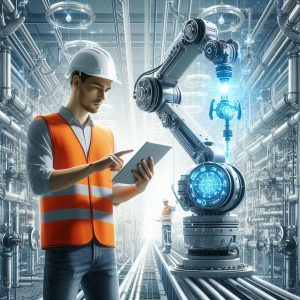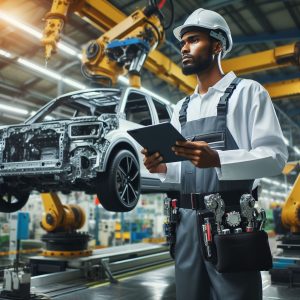Delivery Drivers: Exploring the Impact of AI on Last-Mile Deliveries
Last-mile deliveries are a crucial component of the supply chain, often referred to as the final leg of the journey a package takes from a distribution center to the customer’s doorstep. The advent of artificial intelligence (AI) is revolutionizing this sector, transforming the way goods are delivered and impacting delivery drivers in various ways.
AI-Powered Route Optimization
One of the most significant impacts of AI on last-mile deliveries is the emergence of AI-powered route optimization systems. These systems leverage historical data, real-time traffic conditions, and predictive analytics to determine the most efficient delivery routes for drivers. By optimizing routes, AI helps minimize delivery times, reduce fuel consumption, and enhance overall operational efficiency.
AI-Enabled Autonomous Vehicles
The integration of AI in last-mile deliveries extends beyond route optimization. Self-driving vehicles, powered by AI and machine learning algorithms, are becoming a reality. While fully autonomous vehicles are still being tested and developed, AI-enabled semi-autonomous vehicles are already being used in last-mile deliveries. These vehicles can navigate roads, detect and avoid obstacles, and even interact with pedestrians and other vehicles.
AI and Delivery Drivers’ Jobs
The introduction of AI in last-mile deliveries has sparked debates about its impact on delivery drivers’ jobs. Some experts believe AI will lead to job displacement, as autonomous vehicles may replace human drivers. However, others argue that AI will create new opportunities for delivery drivers, enabling them to focus on tasks that require human intelligence, such as customer interaction and package handling.
In reality, the impact of AI on delivery drivers’ jobs is likely to be a combination of both job displacement and job creation. Some jobs may be lost, but new ones will emerge, requiring different skills and knowledge. For example, AI-powered route optimization systems may reduce the need for drivers with extensive route planning expertise, but it may create demand for drivers who can operate and maintain autonomous vehicles.
Upskilling and Reskilling
To thrive in the evolving landscape of AI-driven last-mile deliveries, delivery drivers must adapt to new technologies and acquire new skills. Upskilling and reskilling initiatives can equip drivers with the necessary knowledge and expertise to operate AI-powered systems, manage autonomous vehicles, and perform tasks that complement AI’s capabilities. This can help them remain relevant in the workforce and create new career opportunities.
AI and Delivery Drivers’ Safety
AI can potentially enhance delivery drivers’ safety on the road. Self-driving vehicles equipped with sensors, cameras, and AI algorithms are designed to operate safely and minimize the risk of accidents. Furthermore, AI-powered systems can alert drivers to potential hazards, road closures, and traffic congestion, enabling them to make informed decisions and avoid dangerous situations.
The incorporation of AI into last-mile deliveries is reshaping the industry and transforming the role of delivery drivers. While AI may have a disruptive impact on some jobs, it also presents opportunities for upskilling, reskilling, and the creation of new roles. By embracing AI and adapting to technological advancements, delivery drivers can stay competitive, enhance their job satisfaction, and continue to play a vital role in the supply chain.
Dangers for Delivery Driver Jobs in the Auto Industry
1. Physical Hazards:
- Delivery drivers face risks associated with driving, including accidents, collisions, and road hazards.
- They also encounter ergonomic risks like lifting heavy packages and navigating tight spaces.
2. Security Threats:
- Delivery drivers handle valuable goods, making them targets for theft and robbery.
- They may also face risks from disgruntled customers or aggressive individuals.
3. Time Constraints:
- Delivery drivers are often under pressure to meet tight deadlines, leading to rushed decision-making and increased safety risks.
4. Health Concerns:
- Long hours of driving and physical exertion can lead to health issues like fatigue, musculoskeletal disorders, and cardiovascular problems.
Possibilities of Job Being Replaced by AI
1. Autonomous Vehicles:
- The development of self-driving cars and trucks has the potential to replace human delivery drivers.
- Autonomous vehicles can operate 24/7, eliminating the need for human drivers.
2. AI-Powered Routing:
- AI algorithms can optimize delivery routes, reducing travel time and fuel consumption.
- This can improve efficiency and reduce costs for delivery companies.
3. Robotic Last-Mile Delivery:
- AI-powered robots can be used for last-mile delivery, especially in dense urban areas.
- These robots can navigate sidewalks and deliver packages to customers’ doorsteps.
How AI Will Be Used to Help in the Job
1. AI-Assisted Driving:
- AI systems can assist delivery drivers with tasks like lane keeping, collision avoidance, and navigation.
- This can reduce driver fatigue and improve safety.
2. Predictive Maintenance:
- AI algorithms can predict when a vehicle needs maintenance, helping to prevent breakdowns and keep delivery operations running smoothly.
3. Automated Package Handling:
- AI-powered systems can automate package sorting and loading, reducing the physical demands on delivery drivers.
4. Customer Service Chatbots:
- AI-powered chatbots can assist customers with inquiries about deliveries, reducing the workload for delivery drivers.
How to Adapt to the Changing Landscape
1. Embrace New Technologies:
- Delivery drivers should be open to adopting new technologies that can enhance their job performance and safety.
2. Develop Skills in AI and Data Analytics:
- Gaining knowledge in these areas can help delivery drivers stay relevant in the face of technological advancements.
3. Diversify Job Skills:
- In addition to driving, delivery drivers can develop skills in customer service, logistics, and warehousing to increase their job opportunities.
4. Stay Up-to-Date with Regulations:
- As the regulatory landscape evolves for autonomous vehicles and AI, delivery drivers need to stay informed about the latest changes.
5. Network with Industry Peers:
- Joining industry organizations and attending conferences can help delivery drivers stay connected and learn about emerging trends.
By embracing change, adapting to new technologies, and diversifying their skills, delivery drivers can navigate the evolving landscape of the auto industry and continue to have successful careers.



